Estimation of LAI in Winter Wheat from Multi-Angular Hyperspectral VNIR Data: Effects of View Angles and Plant Architecture
Abstract
:1. Introduction
2. Materials and Methods
2.1. Experimental Design
2.2. In-Situ Measurements
2.2.1. Spectral Measurement
2.2.2. Canopy Structure Measurements
2.3. Methods
2.3.1. Measured Data Pre-Processing
2.3.2. Spectral Analysis and Indices Calculation
2.3.3. PROSAIL Simulations
3. Results
3.1. Results Based on Measured Data
3.1.1. Variation of HDRFs in the Principle Plane at Two Different Growth Stages
3.1.2. Relationship between LAI and Reflectance
3.1.3. Relationships between LAI and Published Indices
3.1.4. Relationships between LAI and NDSI(x,y) Formula Experimental Combinations
3.2. Results Based on Simulated Data
3.2.1. Relationships between LAI and Published Indices
3.2.2. Relationships between LAI and NDSIs
4. Discussion
4.1. Variation of HDRFs at Different VZAs
4.2. Relationships between LAI and Spectral Vegetation Indices
4.3. Limitations
5. Conclusions
Author Contributions
Funding
Acknowledgments
Conflicts of Interest
Appendix A
| In-situ Results | Simulation Results | |||||||||||
|---|---|---|---|---|---|---|---|---|---|---|---|---|
| NDSI(x,y) W9507 | NDSI(x,y) W411 | NDSI(x,y) W9507 | NDSI(x,y) W411 | |||||||||
| VZA | x | y | R2 | x | y | R2 | x | y | R2 | x | y | R2 |
| −65° | 422 | 445 | 0.969 | 614 | 699 | 0.966 | 500 | 672 | 0.920 | 510 | 622 | 0.882 |
| −55° | 425 | 446 | 0.969 | 611 | 699 | 0.933 | 500 | 672 | 0.884 | 520 | 581 | 0.911 |
| −45° | 952 | 996 | 0.968 | 528 | 715 | 0.900 | 530 | 703 | 0.928 | 581 | 697 | 0.866 |
| −35° | 536 | 720 | 0.969 | 665 | 684 | 0.855 | 572 | 697 | 0.914 | 581 | 697 | 0.905 |
| −25° | 544 | 719 | 0.955 | 525 | 714 | 0.859 | 572 | 697 | 0.886 | 510 | 561 | 0.900 |
| −15° | 541 | 719 | 0.932 | 531 | 715 | 0.887 | 603 | 697 | 0.866 | 551 | 661 | 0.931 |
| 0° | 744 | 990 | 0.91 | 524 | 712 | 0.942 | 590 | 697 | 0.871 | 551 | 672 | 0.911 |
| 15° | 955 | 1000 | 0.91 | 520 | 710 | 0.967 | 641 | 697 | 0.918 | 530 | 622 | 0.912 |
| 25° | 959 | 989 | 0.945 | 516 | 709 | 0.97 | 641 | 697 | 0.946 | 581 | 697 | 0.899 |
| 35° | 957 | 999 | 0.964 | 512 | 708 | 0.97 | 631 | 697 | 0.932 | 581 | 697 | 0.883 |
| 45° | 430 | 450 | 0.928 | 507 | 707 | 0.967 | 572 | 697 | 0.888 | 520 | 641 | 0.818 |
| 55° | 429 | 453 | 0.955 | 571 | 707 | 0.984 | 572 | 697 | 0.844 | 551 | 641 | 0.932 |
| T65° | 421 | 487 | 0.919 | 595 | 702 | 0.978 | 500 | 672 | 0.870 | 500 | 680 | 0.885 |


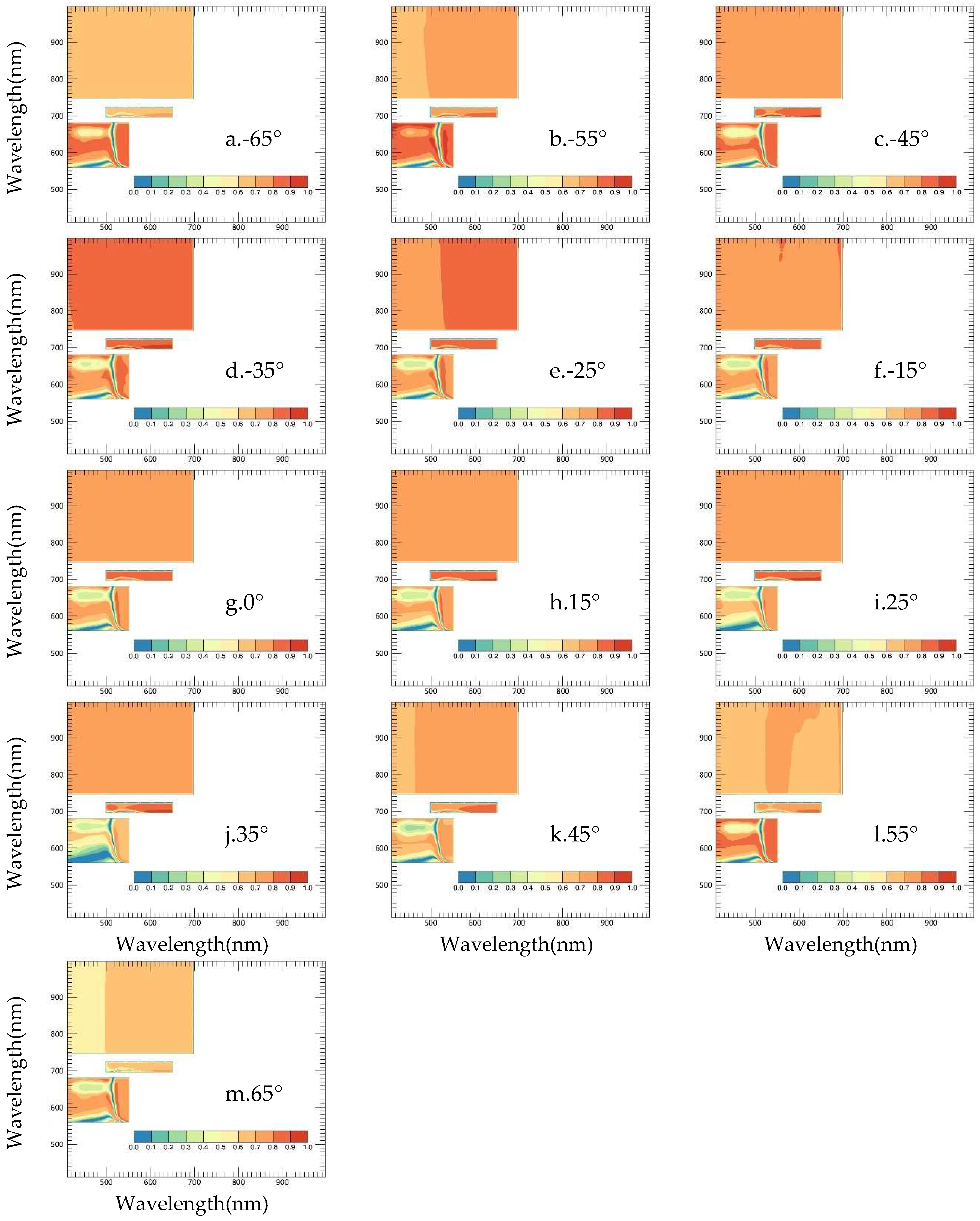

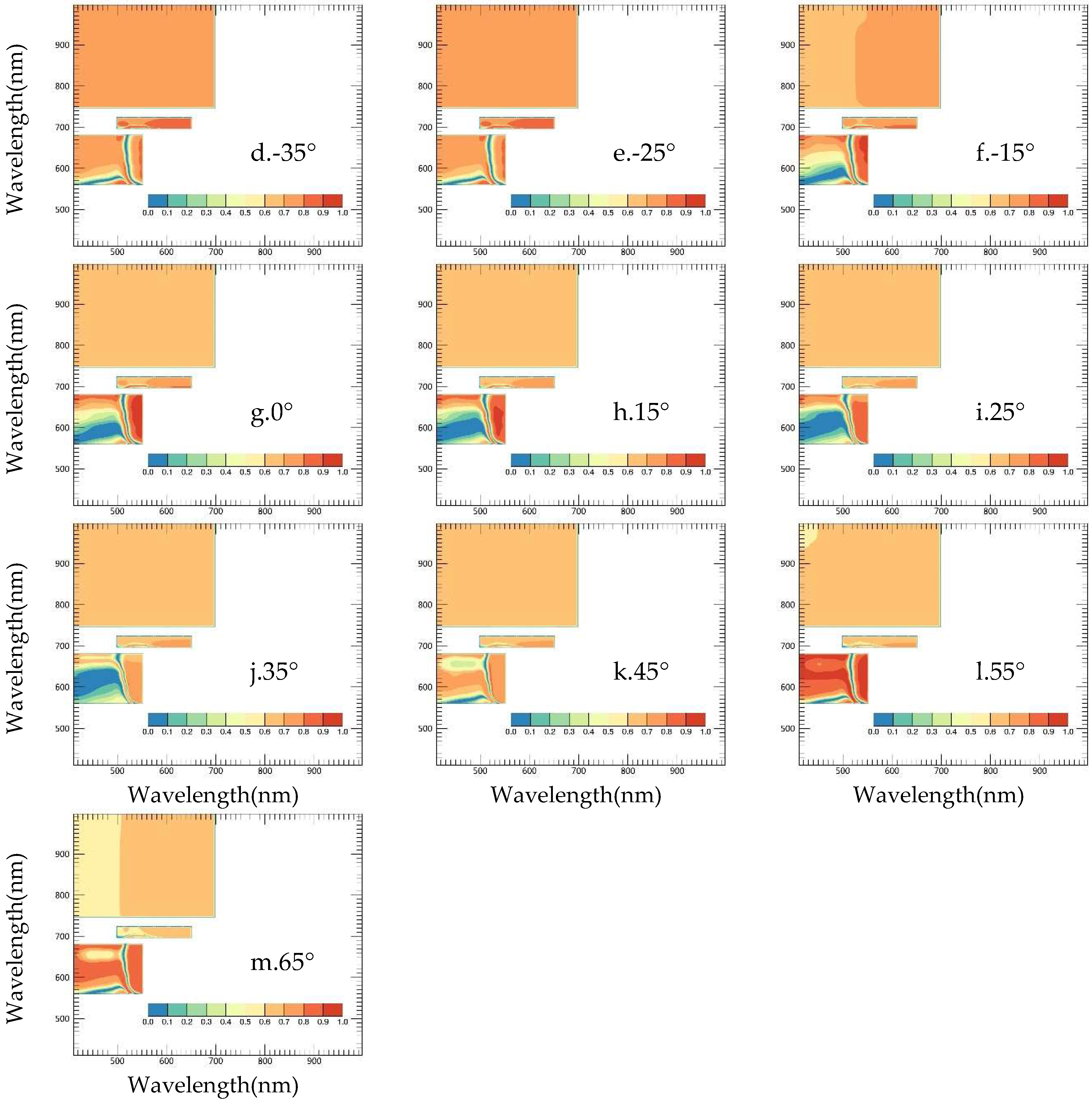
References
- Haboudane, D.; Miller, J.R.; Pattey, E.; Zarco-Tejada, P.J.; Strachan, I.B. Hyperspectral vegetation indices and novel algorithms for predicting green LAI of crop canopies: Modeling and validation in the context of precision agriculture. Remote Sens. Environ. 2004, 90, 337–352. [Google Scholar] [CrossRef]
- Pocewicz, A.; Vierling, L.A.; Lentile, L.B.; Smith, R. View angle effects on relationships between MISR vegetation indices and leaf area index in a recently burned ponderosa pine forest. Remote Sens. Environ. 2007, 107, 322–333. [Google Scholar] [CrossRef]
- Zhao, F.; Gu, X.; Verhoef, W.; Wang, Q.; Yu, T.; Liu, Q.; Huang, H.; Qin, W.; Chen, L.; Zhao, H. A spectral directional reflectance model of row crops. Remote Sens. Environ. 2010, 114, 265–285. [Google Scholar] [CrossRef]
- Chen, J.M.; Liu, J.; Leblanc, S.G.; Lacaze, R.; Roujean, J.-L. Multi-angular optical remote sensing for assessing vegetation structure and carbon absorption. Remote Sens. Environ. 2003, 84, 516–525. [Google Scholar] [CrossRef] [Green Version]
- Chen, J.M.; Leblanc, S.G. A four-scale bidirectional reflectance model based on canopy architecture. IEEE Trans. Geosci. Remote Sens. 1997, 35, 1316–1337. [Google Scholar] [CrossRef] [Green Version]
- Strahler, A.H.; Jupp, D.L. Modeling bidirectional reflectance of forests and woodlands using boolean models and geometric optics. Remote Sens. Environ. 1990, 34, 153–166. [Google Scholar] [CrossRef]
- Breunig, F.M.; Galvão, L.S.; Formaggio, A.R.; Epiphanio, J.C.N. Directional effects on NDVI and LAI retrievals from MODIS: A case study in Brazil with soybean. Int. J. Appl. Earth Obs. Geoinf. 2011, 13, 34–42. [Google Scholar] [CrossRef]
- Galvão, L.S.; Dos Santos, J.R.; Roberts, D.A.; Breunig, F.M.; Toomey, M.; De Moura, Y.M. On intra-annual EVI variability in the dry season of tropical forest: A case study with MODIS and hyperspectral data. Remote Sens. Environ. 2011, 115, 2350–2359. [Google Scholar] [CrossRef]
- Sims, D.A.; Rahman, A.F.; Vermote, E.F.; Jiang, Z. Seasonal and inter-annual variation in view angle effects on MODIS vegetation indices at three forest sites. Remote Sens. Environ. 2011, 115, 3112–3120. [Google Scholar] [CrossRef]
- Galvão, L.S.; Breunig, F.M.; Dos Santos, J.R.; De Moura, Y.M. View-illumination effects on hyperspectral vegetation indices in the Amazonian tropical forest. Int. J. Appl. Earth Obs. Geoinf. 2013, 21, 291–300. [Google Scholar] [CrossRef]
- Burkart, A.; Aasen, H.; Alonso, L.; Menz, G.; Bareth, G.; Rascher, U. Angular dependency of hyperspectral measurements over wheat characterized by a novel UAV based goniometer. Remote Sens. 2015, 7, 725–746. [Google Scholar] [CrossRef] [Green Version]
- Aparicio, N.; Villegas, D.; Royo, C.; Casadesus, J.; Araus, J. Effect of sensor view angle on the assessment of agronomic traits by ground level hyper-spectral reflectance measurements in durum wheat under contrasting Mediterranean conditions. Int. J. Remote Sens. 2004, 25, 1131–1152. [Google Scholar] [CrossRef]
- Jay, S.; Maupas, F.; Bendoula, R.; Gorretta, N. Retrieving LAI, chlorophyll and nitrogen contents in sugar beet crops from multi-angular optical remote sensing: Comparison of vegetation indices and PROSAIL inversion for field phenotyping. Field Crops Res. 2017, 210, 33–46. [Google Scholar] [CrossRef] [Green Version]
- Danner, M.; Berger, K.; Wocher, M.; Mauser, W.; Hank, T. Retrieval of biophysical crop variables from multi-angular canopy spectroscopy. Remote Sens. 2017, 9, 726. [Google Scholar] [CrossRef]
- Galvão, L.S.; Roberts, D.A.; Formaggio, A.R.; Numata, I.; Breunig, F.M. View angle effects on the discrimination of soybean varieties and on the relationships between vegetation indices and yield using off-nadir Hyperion data. Remote Sens. Environ. 2009, 113, 846–856. [Google Scholar] [CrossRef]
- Stagakis, S.; Markos, N.; Sykioti, O.; Kyparissis, A. Monitoring canopy biophysical and biochemical parameters in ecosystem scale using satellite hyperspectral imagery: An application on a Phlomis fruticosa mediterranean ecosystem using multiangular CHRIS/PROBA observations. Remote Sens. Environ. 2010, 114, 977–994. [Google Scholar] [CrossRef]
- Huber, S.; Kneubuehler, M.; Koetz, B.; Schopfer, J.; Zimmermann, N.; Itten, K.I. The potential of spectrodirectional CHRIS/PROBA data for biochemistry estimation. In Proceeding of the Envisat Symposium, Montreux, Switzerland, 23–27 April 2007. [Google Scholar]
- Gemmell, F.; McDonald, A.J. View zenith angle effects on the forest information content of three spectral indices. Remote Sens. Environ. 2000, 72, 139–158. [Google Scholar] [CrossRef]
- Inoue, Y.; Peñuelas, J.; Miyata, A.; Mano, M. Normalized difference spectral indices for estimating photosynthetic efficiency and capacity at a canopy scale derived from hyperspectral and co 2 flux measurements in rice. Remote Sens. Environ. 2008, 112, 156–172. [Google Scholar] [CrossRef]
- Verrelst, J.; Schaepman, M.E.; Koetz, B.; Kneubühler, M. Angular sensitivity analysis of vegetation indices derived from CHRIS/PROBA data. Remote Sens. Environ. 2008, 112, 2341–2353. [Google Scholar] [CrossRef]
- Huang, W.; Niu, Z.; Wang, J.; Liu, L.; Zhao, C.; Liu, Q. Identifying crop leaf angle distribution based on two-temporal and bidirectional canopy reflectance. IEEE Trans. Geosci. Remote Sens. 2006, 44, 3601–3609. [Google Scholar] [CrossRef]
- Darvishzadeh, R.; Skidmore, A.; Atzberger, C.; van Wieren, S. Estimation of vegetation LAI from hyperspectral reflectance data: Effects of soil type and plant architecture. Int. J. Appl. Earth Obs. Geoinf. 2008, 10, 358–373. [Google Scholar] [CrossRef]
- Zou, X.; Mõttus, M. Sensitivity of common vegetation indices to the canopy structure of field crops. Remote Sens. 2017, 9, 994. [Google Scholar] [CrossRef]
- Blackburn, G.A. Quantifying chlorophylls and caroteniods at leaf and canopy scales: An evaluation of some hyperspectral approaches. Remote Sens. Environ. 1998, 66, 273–285. [Google Scholar] [CrossRef]
- Elvidge, C.D.; Chen, Z. Comparison of broad-band and narrow-band red and near-infrared vegetation indices. Remote Sens. Environ. 1995, 54, 38–48. [Google Scholar] [CrossRef]
- Gong, P.; Pu, R.; Miller, J.R. Correlating leaf area index of ponderosa pine with hyperspectral CASI data. Can. J. Remote Sens. 1992, 18, 275–282. [Google Scholar] [CrossRef]
- Lee, K.-S.; Cohen, W.B.; Kennedy, R.E.; Maiersperger, T.K.; Gower, S.T. Hyperspectral versus multispectral data for estimating leaf area index in four different biomes. Remote Sens. Environ. 2004, 91, 508–520. [Google Scholar] [CrossRef]
- Mutanga, O.; Skidmore, A.K. Narrow band vegetation indices overcome the saturation problem in biomass estimation. Int. J. Remote Sens. 2004, 25, 3999–4014. [Google Scholar] [CrossRef]
- Jacquemoud, S.; Verhoef, W.; Baret, F.; Bacour, C.; Zarco-Tejada, P.J.; Asner, G.P.; François, C.; Ustin, S.L. PROSPECT + SAIL models: A review of use for vegetation characterization. Remote Sens. Environ. 2009, 113, 56–66. [Google Scholar] [CrossRef]
- Chen, H.; Niu, Z.; Huang, W.; Feng, J. Predicting leaf area index in wheat using an improved empirical model. J. Appl. Remote Sens. 2013, 7, 073577. [Google Scholar] [CrossRef]
- Liu, L.; Wang, J.; Bao, Y.; Huang, W.; Ma, Z.; Zhao, C. Predicting winter wheat condition, grain yield and protein content using multi-temporal EnviSat-Asar and Landsat TM satellite images. Int. J. Remote Sens. 2006, 27, 737–753. [Google Scholar] [CrossRef]
- De Moura, Y.M.; Hilker, T.; Gonçalves, F.G.; Galvão, L.S.; Dos Santos, J.R.; Lyapustin, A.; Maeda, E.E.; De Jesus Silva, C.V. Scaling estimates of vegetation structure in amazonian tropical forests using multi-angle MODIS observations. Int. J. Appl. Earth Obs. Geoinf. 2016, 52, 580–590. [Google Scholar] [CrossRef] [PubMed]
- Koukal, T.; Atzberger, C.; Schneider, W. Evaluation of semi-empirical BRDF models inverted against multi-angle data from a digital airborne frame camera for enhancing forest type classification. Remote Sens. Environ. 2014, 151, 27–43. [Google Scholar] [CrossRef]
- Feng, D.; Chen, J.M.; Plummer, S.; Mingzhen, C.; Pisek, J. Algorithm for global leaf area index retrieval using satellite imagery. IEEE Trans. Geosci. Remote Sens. 2006, 44, 2219–2229. [Google Scholar] [CrossRef] [Green Version]
- Roujean, J.L.; Leroy, M.; Deschamps, P.Y. A bidirectional reflectance model of the earth’s surface for the correction of remote sensing data. J. Geophys. Res. Atmos. 1992, 97, 20455–20468. [Google Scholar] [CrossRef]
- Lucht, W.; Schaaf, C.B.; Strahler, A.H. An algorithm for the retrieval of albedo from space using semiempirical BRDF models. IEEE Trans. Geosci. Remote Sens. 2000, 38, 977–998. [Google Scholar] [CrossRef]
- Schaaf, C.B.; Gao, F.; Strahler, A.H.; Lucht, W.; Li, X.; Tsang, T.; Strugnell, N.C.; Zhang, X.; Jin, Y.; Muller, J.-P. First operational BRDF, albedo nadir reflectance products from MODIS. Remote Sens. Environ. 2002, 83, 135–148. [Google Scholar] [CrossRef] [Green Version]
- Wanner, W.; Strahler, A.; Hu, B.; Lewis, P.; Muller, J.P.; Li, X.; Schaaf, C.; Barnsley, M. Global retrieval of bidirectional reflectance and albedo over land from EOS MODIS and MISR data: Theory and algorithm. J. Geophys. Res. Atmos. 1997, 102, 17143–17161. [Google Scholar] [CrossRef] [Green Version]
- Jiao, Z.; Hill, M.J.; Schaaf, C.B.; Zhang, H.; Wang, Z.; Li, X. An anisotropic flat index (AFX) to derive BRDF archetypes from MODIS. Remote Sens. Environ. 2014, 141, 168–187. [Google Scholar] [CrossRef]
- Wanner, W.; Li, X.; Strahler, A. On the derivation of kernels for kernel-driven models of bidirectional reflectance. J. Geophys. Res. Atmos. 1995, 100, 21077–21089. [Google Scholar] [CrossRef]
- Sims, D.A.; Gamon, J.A. Relationships between leaf pigment content and spectral reflectance across a wide range of species, leaf structures and developmental stages. Remote Sens. Environ. 2002, 81, 337–354. [Google Scholar] [CrossRef]
- Dash, J.; Curran, P.J. The MERIS terrestrial chlorophyll index. Int. J. Remote Sens. 2004, 25, 5403–5413. [Google Scholar] [CrossRef]
- Tucker, C.J. Red and photographic infrared linear combinations for monitoring vegetation. Remote Sens. Environ. 1979, 8, 127–150. [Google Scholar] [CrossRef] [Green Version]
- Vogelmann, J.; Rock, B.; Moss, D. Red edge spectral measurements from sugar maple leaves. Int. J. Remote Sens. 1993, 14, 1563–1575. [Google Scholar] [CrossRef]
- Huete, A.; Liu, H.; Batchily, K.; Van Leeuwen, W. A comparison of vegetation indices over a global set of TM images for EOS-MODIS. Remote Sens. Environ. 1997, 59, 440–451. [Google Scholar] [CrossRef]
- Qi, J.; Chehbouni, A.; Huete, A.; Kerr, Y.; Sorooshian, S. A modified soil adjusted vegetation index. Remote Sens. Environ. 1994, 48, 119–126. [Google Scholar] [CrossRef]
- Broge, N.H.; Leblanc, E. Comparing prediction power and stability of broadband and hyperspectral vegetation indices for estimation of green leaf area index and canopy chlorophyll density. Remote Sens. Environ. 2001, 76, 156–172. [Google Scholar] [CrossRef]
- Vincini, M.; Frazzi, E.; D’Alessio, P. Angular dependence of maize and sugar beet vis from directional CHRIS/PROBA data. In Proceeding of the 4th ESA CHRIS PROBA Workshop, ESRIN, Frascati, Italy, 19–21 Septembar 2006; pp. 19–21. [Google Scholar]
- Peñuelas, J.; Filella, I.; Lloret, P.; Muñoz, F.; Vilajeliu, M. Reflectance assessment of mite effects on apple trees. Int. J. Remote Sens. 1995, 16, 2727–2733. [Google Scholar] [CrossRef]
- Peñuelas, J.; Gamon, J.; Fredeen, A.; Merino, J.; Field, C. Reflectance indices associated with physiological changes in nitrogen-and water-limited sunflower leaves. Remote Sens. Environ. 1994, 48, 135–146. [Google Scholar] [CrossRef]
- Gamon, J.; Serrano, L.; Surfus, J. The photochemical reflectance index: An optical indicator of photosynthetic radiation use efficiency across species, functional types, and nutrient levels. Oecologia 1997, 112, 492–501. [Google Scholar] [CrossRef] [PubMed]
- He, L.; Song, X.; Feng, W.; Guo, B.-B.; Zhang, Y.-S.; Wang, Y.-H.; Wang, C.-Y.; Guo, T.-C. Improved remote sensing of leaf nitrogen concentration in winter wheat using multi-angular hyperspectral data. Remote Sens. Environ. 2016, 174, 122–133. [Google Scholar] [CrossRef]
- Atzberger, C.; Darvishzadeh, R.; Immitzer, M.; Schlerf, M.; Skidmore, A.; Le Maire, G. Comparative analysis of different retrieval methods for mapping grassland leaf area index using airborne imaging spectroscopy. Int. J. Appl. Earth Obs. Geoinf. 2015, 43, 19–31. [Google Scholar] [CrossRef] [Green Version]
- Wang, L.; Dong, T.; Zhang, G.; Niu, Z. LAI retrieval using PROSAIL model and optimal angle combination of multi-angular data in wheat. IEEE J. Sel. Top. Appl. Earth Obs. Remote Sens. 2013, 6, 1730–1736. [Google Scholar] [CrossRef]
- Gitelson, A.A.; Gritz, Y.; Merzlyak, M.N. Relationships between leaf chlorophyll content and spectral reflectance and algorithms for non-destructive chlorophyll assessment in higher plant leaves. J. Plant Physiol. 2003, 160, 271–282. [Google Scholar] [CrossRef] [PubMed]
- Jackson, R.D.; Pinter, P.J. Spectral response of architecturally different wheat canopies. Remote Sens. Environ. 1986, 20, 43–56. [Google Scholar] [CrossRef]
- Curran, P.J.; Dungan, J.L.; Macler, B.A.; Plummer, S.E.; Peterson, D.L. Reflectance spectroscopy of fresh whole leaves for the estimation of chemical concentration. Remote Sens. Environ. 1992, 39, 153–166. [Google Scholar] [CrossRef]
- Fourty, T.; Baret, F.; Jacquemoud, S.; Schmuck, G.; Verdebout, J. Leaf optical properties with explicit description of its biochemical composition: Direct and inverse problems. Remote Sens. Environ. 1996, 56, 104–117. [Google Scholar] [CrossRef]
- Walter-Shea, E.; Privette, J.; Cornell, D.; Mesarch, M.A.; Hays, C. Relations between directional spectral vegetation indices and leaf area and absorbed radiation in alfalfa. Remote Sens. Environ. 1997, 61, 162–177. [Google Scholar] [CrossRef]
- Gamon, J.; Surfus, J. Assessing leaf pigment content and activity with a reflectometer. New Phytol. 1999, 143, 105–117. [Google Scholar] [CrossRef] [Green Version]
- Gitelson, A.; Merzlyak, M.N. Quantitative estimation of chlorophyll-a using reflectance spectra: Experiments with autumn chestnut and maple leaves. J. Photochem. Photobiol. B Biol. 1994, 22, 247–252. [Google Scholar] [CrossRef]
- Zarco-Tejada, P.J.; Miller, J.R.; Noland, T.L.; Mohammed, G.H.; Sampson, P.H. Scaling-up and model inversion methods with narrowband optical indices for chlorophyll content estimation in closed forest canopies with hyperspectral data. IEEE Trans. Geosci. Remote Sens. 2001, 39, 1491–1507. [Google Scholar] [CrossRef] [Green Version]
- Wu, C.; Niu, Z.; Wang, J.; Gao, S.; Huang, W. Predicting leaf area index in wheat using angular vegetation indices derived from in situ canopy measurements. Can. J. Remote Sens. 2010, 36, 301–312. [Google Scholar] [CrossRef]
- Atzberger, C.; Richter, K. Spatially constrained inversion of radiative transfer models for improved LAI mapping from future sentinel-2 imagery. Remote Sens. Environ. 2012, 120, 208–218. [Google Scholar] [CrossRef]
- Olioso, A.; Inoue, Y.; Ortega-Farias, S.; Demarty, J.; Wigneron, J.-P.; Braud, I.; Jacob, F.; Lecharpentier, P.; Ottlé, C.; Calvet, J.-C. Future directions for advanced evapotranspiration modeling: Assimilation of remote sensing data into crop simulation models and svat models. Irrig. Drain. Syst. 2005, 19, 377–412. [Google Scholar] [CrossRef]
- Baret, F.; Houles, V.; Guérif, M. Quantification of plant stress using remote sensing observations and crop models: The case of nitrogen management. J. Exp. Bot. 2007, 58, 869–880. [Google Scholar] [CrossRef] [PubMed]
- Zhang, X.; Jiao, Z.; Dong, Y.; Zhang, H.; Li, Y.; He, D.; Ding, A.; Yin, S.; Cui, L.; Chang, Y. Potential investigation of linking PROSAIL with the ross-li BRDF model for vegetation characterization. Remote Sens. 2018, 10, 437. [Google Scholar] [CrossRef]
- Pisek, J.; Chen, J.M.; Nilson, T. Estimation of vegetation clumping index using MODIS BRDF data. Int. J. Remote Sens. 2011, 32, 2645–2657. [Google Scholar] [CrossRef]
- Gao, F. Detecting vegetation structure using a kernel-based BRDF model. Remote Sens. Environ. 2003, 86, 198–205. [Google Scholar] [CrossRef]
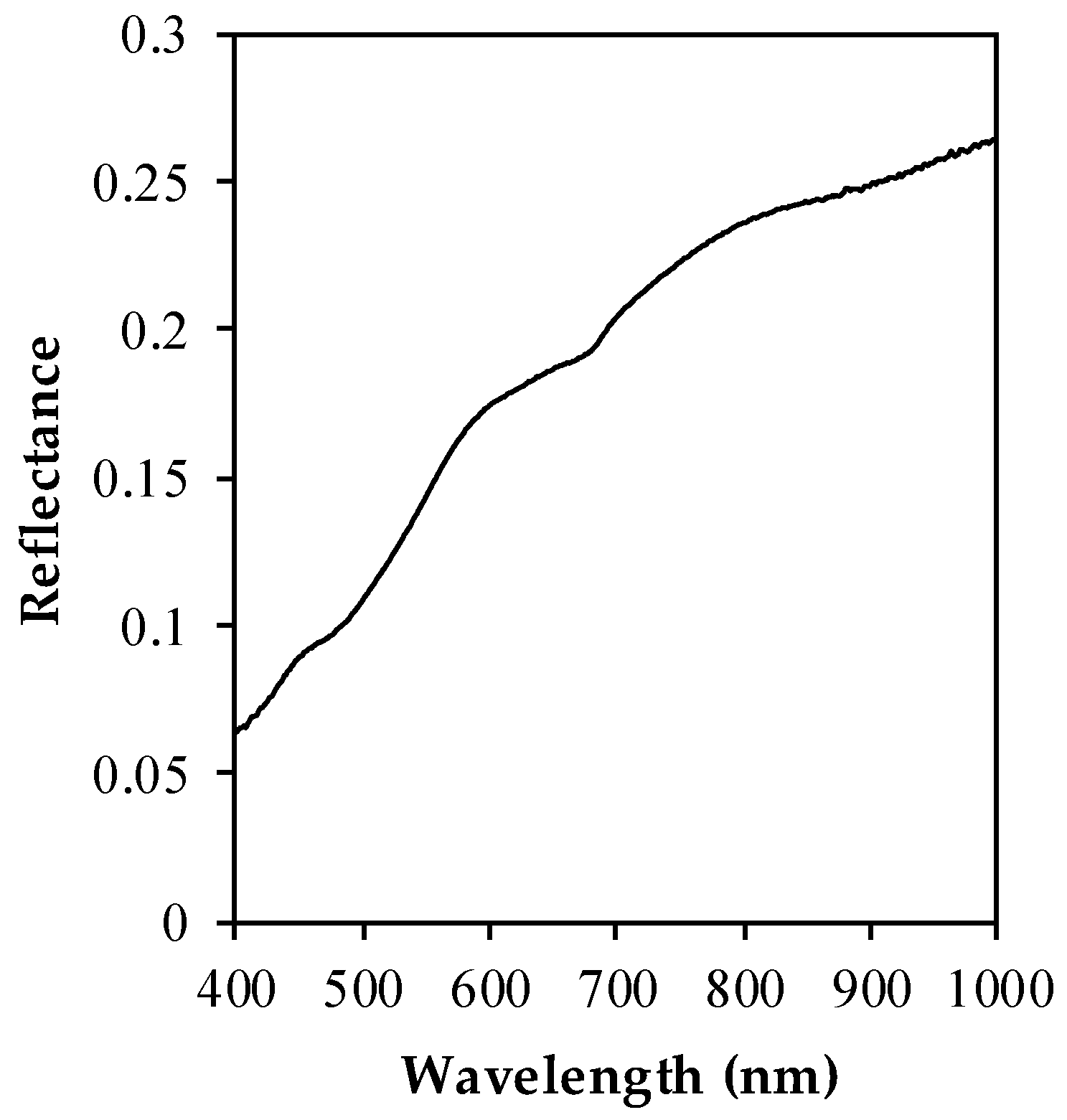
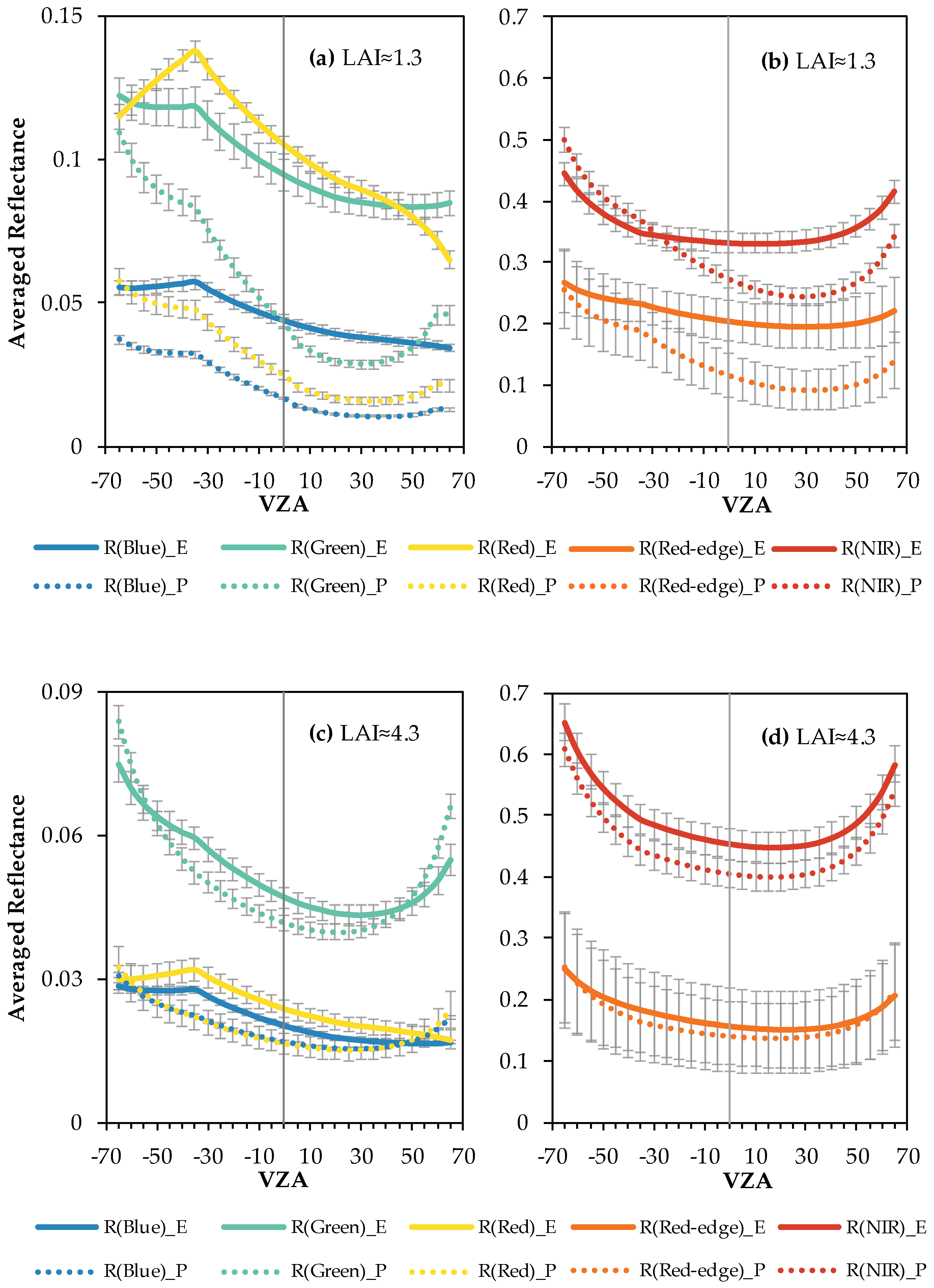


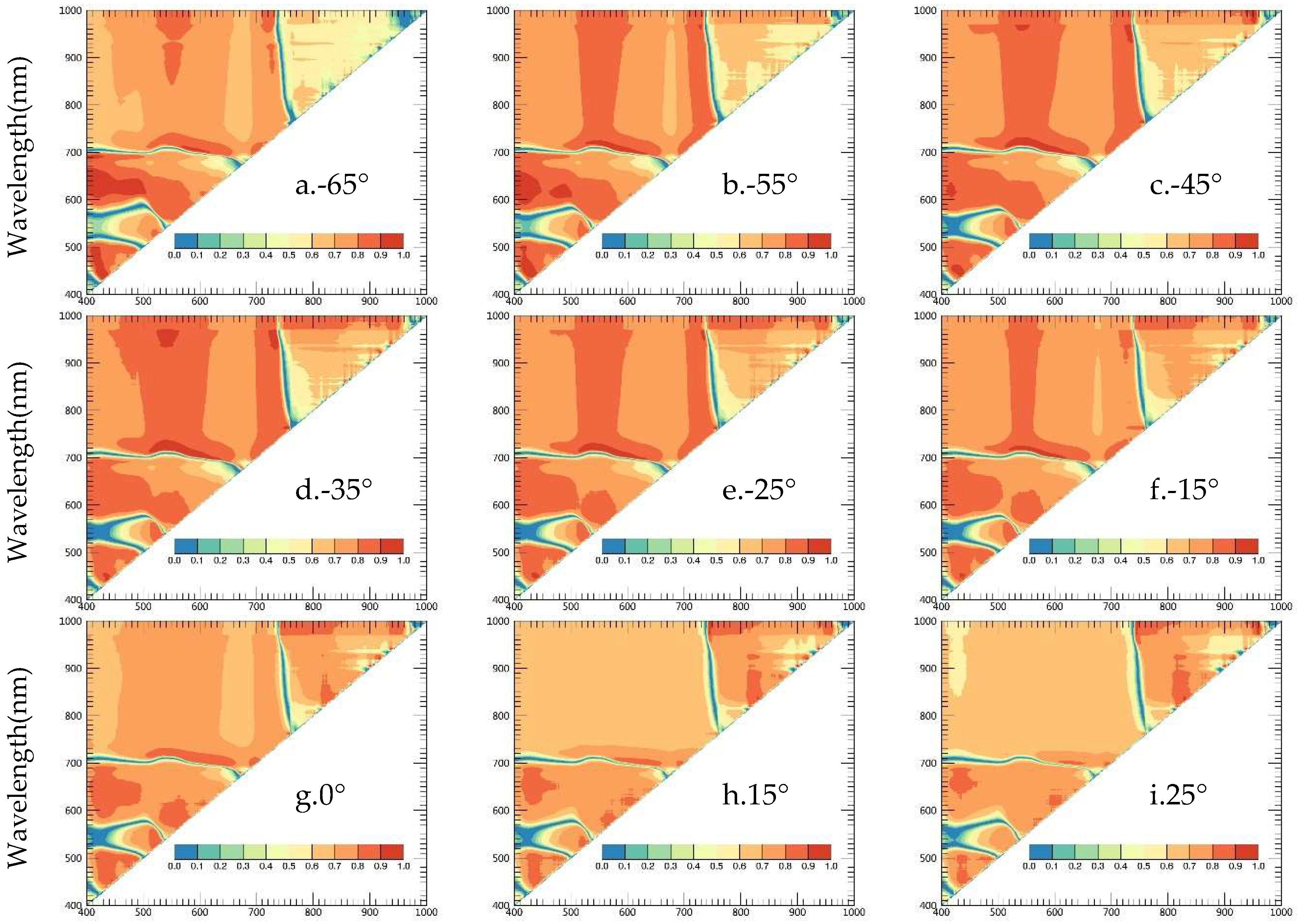
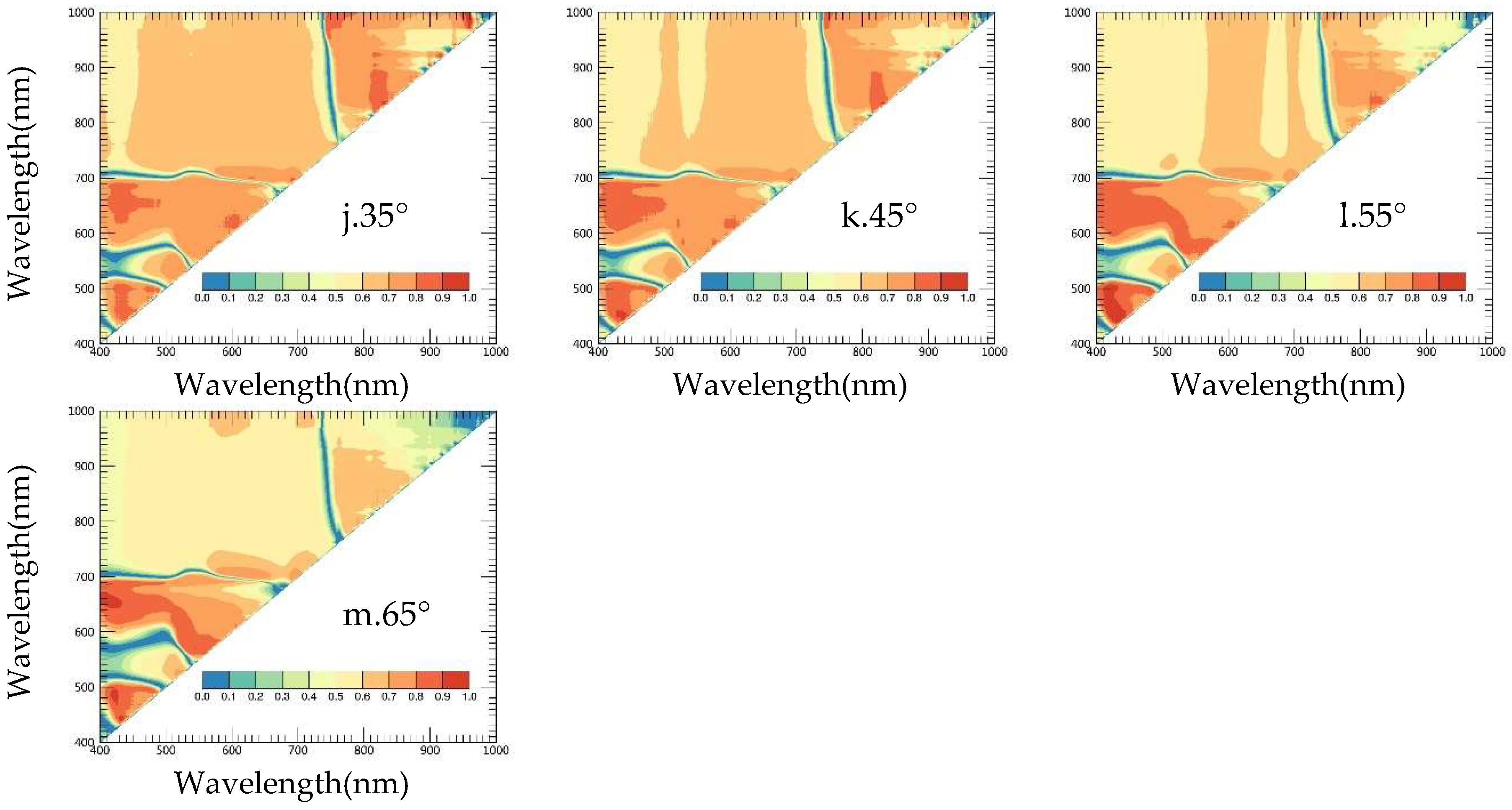
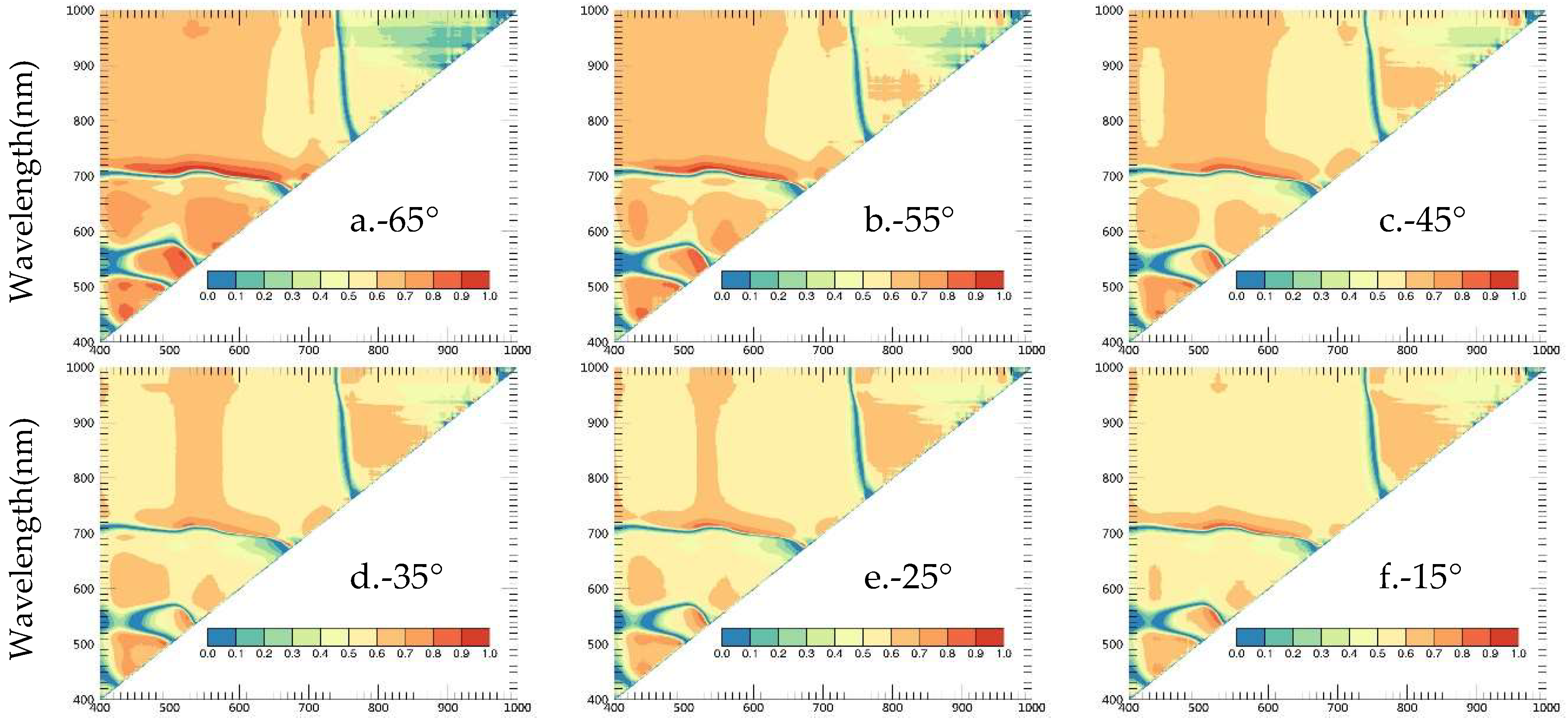
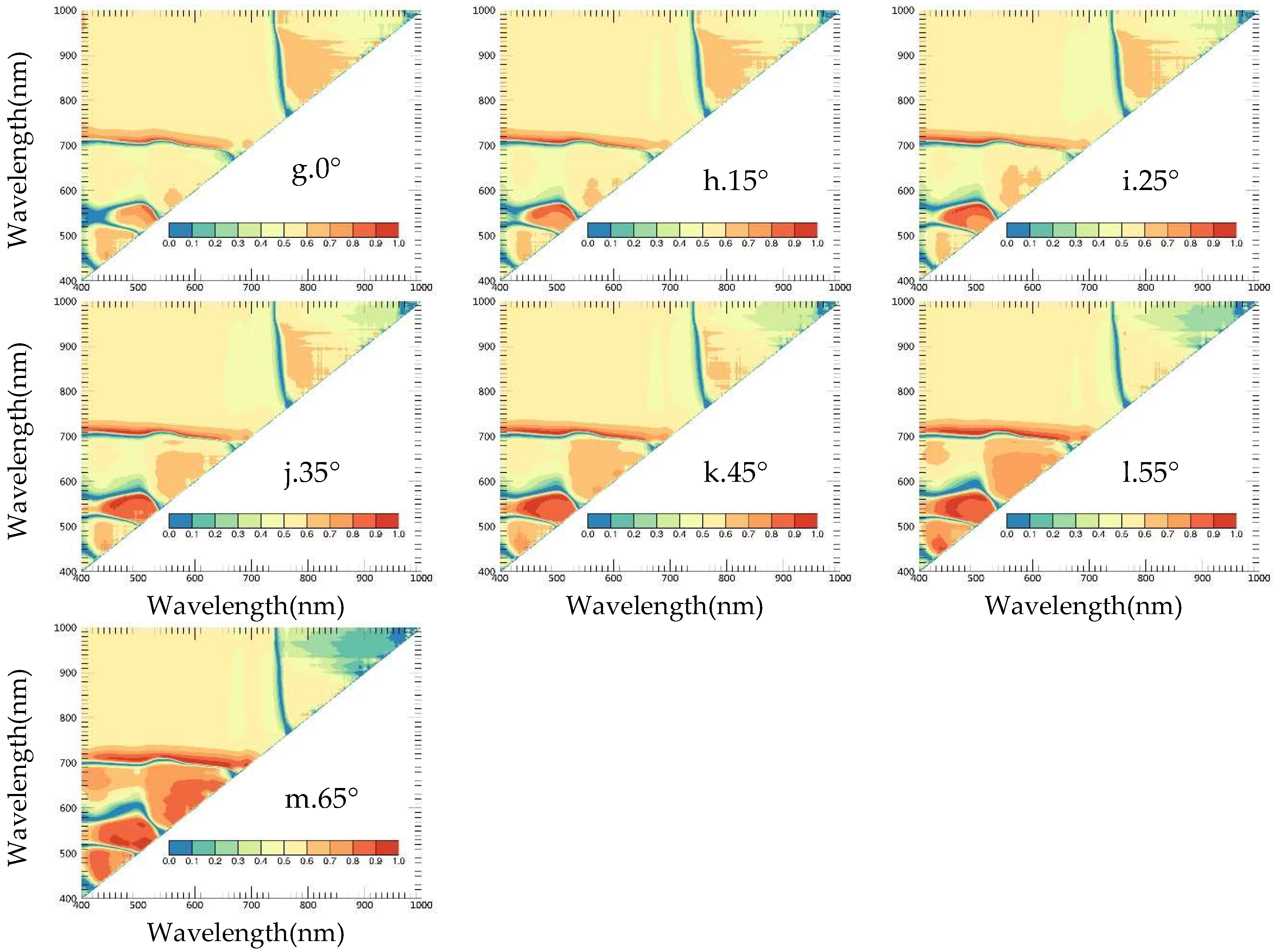



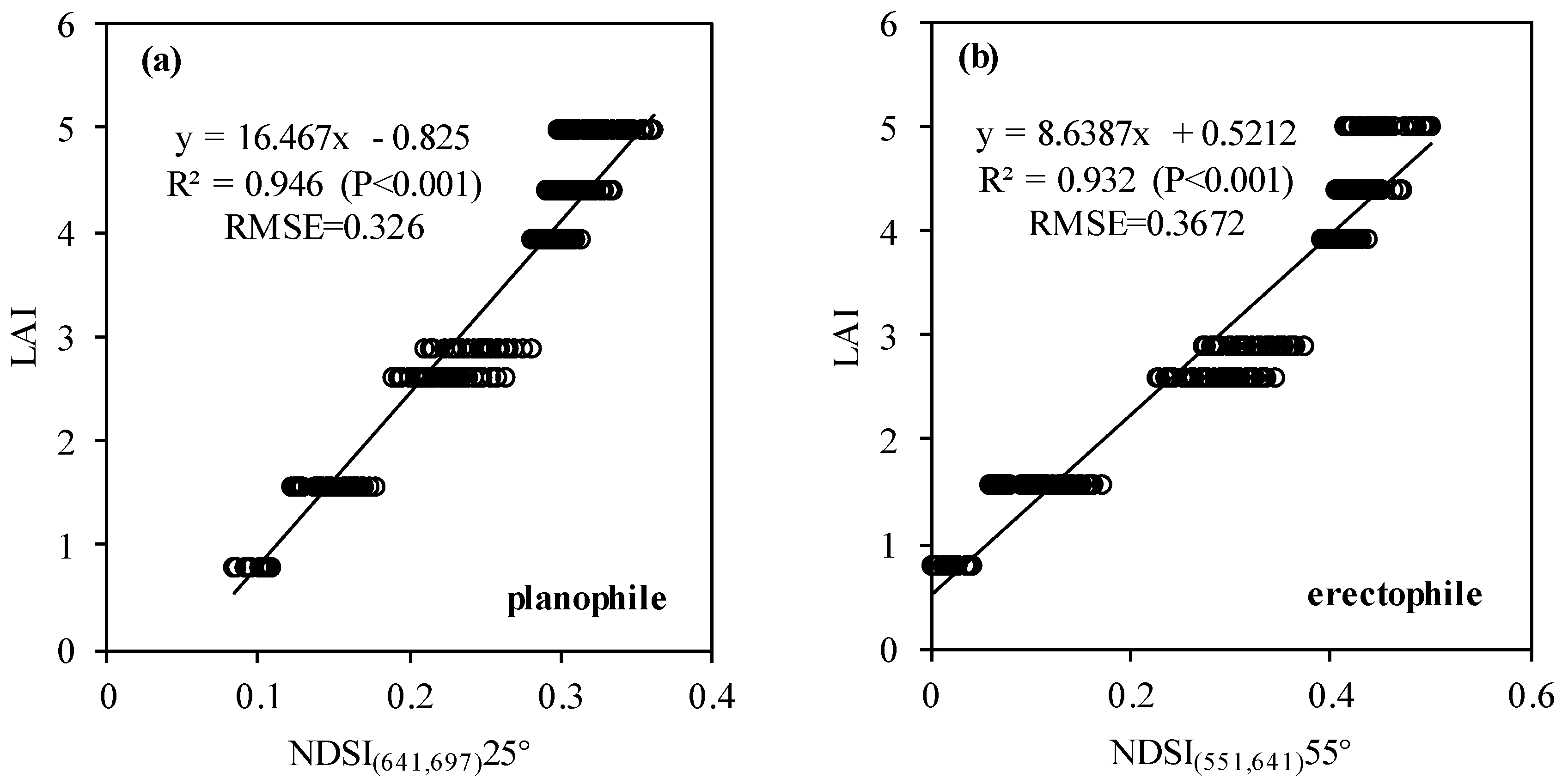
| Plot Number | Observed Date | Observed Time (Beginning) | SZA (°) | Period | Type | LAI | MTA |
|---|---|---|---|---|---|---|---|
| 1 | 1 April 2004 | 11:04:00 | 39 | returning green | W9507 | 1.30 | 38.70 |
| 2 | 17 April 2004 | 11:04:00 | 33.2 | jointing | W9507 | 4.01 | 26.10 |
| 3 | 3 May 2004 | 10:14:00 | 35.1 | heading | W9507 | 4.29 | 24.00 |
| 4 | 11 May 2004 | 15:32:00 | 48.4 | flowering | W9507 | 3.85 | 36.40 |
| 5 | 20 May 2004 | 14:31:00 | 36 | milk ripening | W9507 | 2.98 | 32.79 |
| 6 | 30 May 2004 | 14:18:00 | 32.4 | wax ripeness | W9507 | 1.06 | 41.42 |
| 7 | 9 June 2004 | 10:05:00 | 32 | senescence | W9507 | 0.84 | - |
| 8 | 20 April 2011 | 10:12:00 | 39.4 | jointing | W9507 | 3.87 | - |
| 9 | 6 May 2011 | 9:41:00 | 40.1 | heading | W9507 | 3.41 | - |
| 10 | 13 May 2011 | 9:36:00 | 39.7 | flowering | W9507 | 2.92 | - |
| 11 | 1 April 2004 | 10:15:00 | 44.8 | returning green | W411 | 1.31 | 53.72 |
| 12 | 17 April 2004 | 10:20:00 | 38.6 | jointing | W411 | 4.25 | 71.85 |
| 13 | 3 May 2004 | 14:27:00 | 38.2 | heading | W411 | 4.28 | 61.10 |
| 14 | 11 May 2004 | 13:58:00 | 32 | flowering | W411 | 2.27 | 63.80 |
| 15 | 20 May 2004 | 10:09:00 | 32.7 | milk ripening | W411 | 2.47 | 66.42 |
| 16 | 30 May 2004 | 10:00:00 | 33.3 | wax ripeness | W411 | 1.62 | 56.42 |
| 17 | 9 June 2004 | 9:26:00 | 39.1 | senescence | W411 | 0.92 | - |
| 18 | 20 April 2011 | 10:08:00 | 40 | jointing | W411 | 4.44 | - |
| 19 | 10 May 2011 | 9:45:00 | 38.8 | flowering | W411 | 3.48 | - |
| 20 | 13 May 2011 | 9:33:00 | 40.3 | flowering | W411 | 3.42 | - |
| Indices | Formulation | Reference |
|---|---|---|
| Simple greenness indices: normalized difference or simple ratio formula of NIR, red (including red-edge), blue (used in MSR2) band combinations. | ||
| MSR2 (Modified Simple Ratio) | (R750 − R445)/(R705 − R445) | [41] |
| MTCI (MERIS Terrestrial Chlorophyll index) | (R754 − R709)/(R709 − R681) | [42] |
| NDVI (Normalized Difference Vegetation Index) | (R800 − R670)/(R800 + R670) | [43] |
| VOG (Vogelmann Index) | R740/R720 | [44] |
| Advanced greenness indices: more complicated formula of NIR and visible bands combinations | ||
| EVI (Enhanced Vegetation Index) | [45] | |
| MSAVI (Improved Soil Adjusted Vegetation Index) | [46] | |
| TVI (Triangular Vegetation Index) | 0.5[120(R750 − R550) − 200(R670 − R550)] | [47] |
| SPVI (Spectral polygon vegetation index) | 0.4[3.7(R800 − R670) − 1.2|R530 − R670|] | [48] |
| Stress indices: normalized difference or simple ratio formula of visible bands combinations | ||
| SRPI (Simple Ratio Pigment Index) | R430/R680 | [49] |
| NPCI (Normalized Pigment Chlorophyll index) | (R680 − R430)/(R680 + R430) | [50] |
| PRI (Photochemical Reflectance Index) | (R531 − R570)/(R531 + R570) | [51] |
| Model | Parameter | Units | Fixed value | Min | Max |
|---|---|---|---|---|---|
| PROSPECT-5B | LAI | - | - | 0.5 | 5 |
| MTA | deg | - | 15 | 70 | |
| Hot | - | - | 0.01 | 1 | |
| Skyl | - | 0.1 | - | - | |
| Cab | μg·cm−2 | - | 45 | 55 | |
| Ccar | µg·cm-2 | - | 9 | 11 | |
| 4SAIL | Cm | g·cm-2 | 0.0135 | - | |
| Cw | cm | - | 0.01 | 0.02 | |
| Cbp | - | 0 | - | - | |
| N | - | - | 1.3 | 1.7 | |
| SZA | deg | 35 | - | - | |
| VZA | deg | - | −65 | 65 | |
| RAA | deg | - | 0 | 180 |
| Erectophile Variety | Planophile Variety | ||||||
|---|---|---|---|---|---|---|---|
| VI | Optimal Angle (deg) | Optimal R2 | AD_R2 | VI | Optimal Angle (deg) | Optimal R2 | AD_R2 |
| MSAVI | 10 | 0.725 * | 0.090 | NPCI | 65 | 0.852 ** | 0.055 |
| EVI | −10 | 0.706 * | 0.098 | SRPI | −65 | 0.926 *** | 0.094 |
| TVI | −15 | 0.756 * | 0.119 | PRI | −65 | 0.871 ** | 0.133 |
| SPVI | −25 | 0.774 ** | 0.121 | SPVI | 25 | 0.899 ** | 0.171 |
| NDVI | −65 | 0.560 * | 0.138 | EVI | 25 | 0.902 ** | 0.174 |
| VOG | −65 | 0.654 * | 0.207 | TVI | 30 | 0.883 ** | 0.187 |
| PRI | −65 | 0.665 * | 0.297 | MSAVI | 25 | 0.921 *** | 0.211 |
| MTCI | −35 | 0.649 * | 0.300 | MSR2 | −35 | 0.946 *** | 0.283 |
| MSR2 | −65 | 0.700 * | 0.355 | NDVI | −35 | 0.723 * | 0.283 |
| NPCI | 65 | 0.721 * | 0.372 | VOG | −35 | 0.900 ** | 0.341 |
| SRPI | −65 | 0.747 * | 0.432 | MTCI | −35 | 0.933 ** | 0.390 |
© 2018 by the authors. Licensee MDPI, Basel, Switzerland. This article is an open access article distributed under the terms and conditions of the Creative Commons Attribution (CC BY) license (http://creativecommons.org/licenses/by/4.0/).
Share and Cite
Chen, H.; Huang, W.; Li, W.; Niu, Z.; Zhang, L.; Xing, S. Estimation of LAI in Winter Wheat from Multi-Angular Hyperspectral VNIR Data: Effects of View Angles and Plant Architecture. Remote Sens. 2018, 10, 1630. https://doi.org/10.3390/rs10101630
Chen H, Huang W, Li W, Niu Z, Zhang L, Xing S. Estimation of LAI in Winter Wheat from Multi-Angular Hyperspectral VNIR Data: Effects of View Angles and Plant Architecture. Remote Sensing. 2018; 10(10):1630. https://doi.org/10.3390/rs10101630
Chicago/Turabian StyleChen, Hanyue, Wenjiang Huang, Wang Li, Zheng Niu, Liming Zhang, and Shihe Xing. 2018. "Estimation of LAI in Winter Wheat from Multi-Angular Hyperspectral VNIR Data: Effects of View Angles and Plant Architecture" Remote Sensing 10, no. 10: 1630. https://doi.org/10.3390/rs10101630







